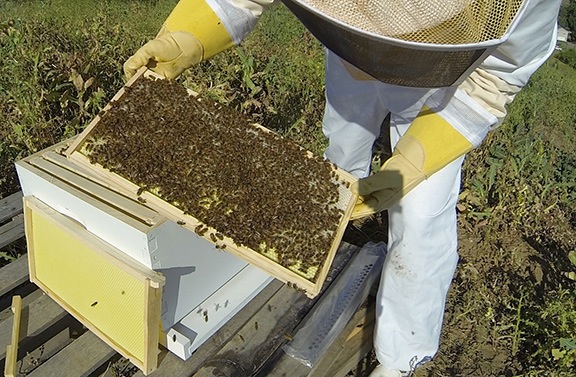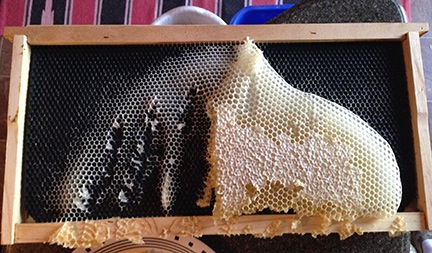A beekeeper ought to know, right?
I started keeping bees in June 2013. So, yes, it hasn’t been that long and no, I’m not an “expert” (yet). But I do know some things about bees and beekeeping and honey.

This is me last year, examining a honey frame in one of my hives. Can’t believe how clean my gloves still were!
I posted a status update on Facebook yesterday that mentioned snacking on a piece of honeycomb from my beehives. The comments I got from my friends made me realize that there are some misconceptions — or simply knowledge gaps — out there about honey. I thought I’d take a few moments to clear things up.
Nature’s Perfect Food
I like to think of honey as nature’s perfect food. It’s created by nature, requires no refrigeration to preserve, and it doesn’t go bad. Smithsonian’s “The Science Behind Honey’s Eternal Shelf Life” elaborates on this. It mentions that the bees “regurgitate the nectar from their mouths into the combs combs to make honey.” But no, honey is not bee vomit.
Beeswax

In this shot, I’m scraping the wax caps off a honey frame before putting it into the extractor to the left.
Bees store honey in wax honeycomb they create. Most beekeepers use Langstroth hives that provide their bees with frames specially designed for them to create nice, neat honeycombs. This makes it easy to extract the honey using centrifugal force in a honey extractor.
Some beekeepers prefer more natural hives, such as top-bar hives, which allow the bees to create comb as they might in the wild. (I don’t know how they extract honey from natural comb. Maybe they just sell the honey in the comb.)

This photo shows some natural comb made on a Langstroth frame. This is not normal. I think it was a result of the frame’s plastic surface not being properly coated with beeswax by the manufacturer. I won’t be buying my frames there anymore.
Beeswax is edible. If you buy comb honey, you can eat the entire thing. I occasionally have comb honey that I get from removing unwanted natural comb from my Langstroth hives. I eat it with a spoon, chewing it gently until the honey is gone from the wax. The wax does not stick to my teeth. It ends up as a little wax ball that I spit out (like gum). Swallowing it would not hurt me, but I don’t think there’s any reason to.
Buying Honey
The absolute best place to buy honey is at a farmer’s market. A real farmer’s market. Chances are, you’ll be buying the honey from the beekeeper.
And if you don’t think there’s a difference between store-bought honey and fresh honey from a beekeeper, think again. The first time I tasted my own honey, I threw away all the store-bought crap I had in my cabinets. Then I gave away too much of my honey and had to ration the last jar so it would last a whole year. (It didn’t.)
Raw honey is best. Don’t buy the flavored crap. Who knows what they added?
Creamed honey is honey that has been processed to control crystallization. Nothing is added. It’s just been stirred or whipped at a specific temperature.
Spending a lot of money for honey does not mean you’ll get better honey. It just means that someone’s marketing scheme worked on you.
Honey sold in glass jars is not necessarily any better than honey sold in plastic jars. In fact, many beekeepers package their honey in plastic containers — even the bear squeeze containers! — for sale because they’re cost effective, they’re lightweight, and they don’t break. Do you think it’s a good idea to shlep heavy cases of glass jars around from one farmer’s market to the next?
Storing Honey
Store honey in the container you got it in. I generally put my honey comb in plastic containers so that’s what I store it in. When I extract honey, I usually put it in quart-sized glass mason jars so that’s what I store it in.
If you’re refrigerating your honey, take it out of the refrigerator now. It doesn’t belong there. Refrigerating it can hasten crystallization. While crystallization doesn’t make the honey taste bad, it does ruin its nice, smooth texture.
If your honey gets crystalized, you can heat it to dissolve the crystals. You can do this in the microwave if you like or by putting the honey container in a bath of warm water. They crystals will come back when the honey cools.
Beekeeping Costs
The main cost of producing honey is buying the equipment: hive boxes, frames, bottoms and tops, beekeeper suit, etc. My initial investment was about $500. I’ve since spent about $1,000 more — I really do know how to throw money at a hobby — but now have what I need for six hives. You can save money by building your own bee boxes and frames.
All of the equipment is reusable, so once you’ve made the investment, the only thing you’ll spend to keep bees and make honey is your time. This year, I was neglectful — my new home under construction kept me very busy — but my bees didn’t seem to care. They did their thing — including keeping my vegetable garden pollinated — and I pulled another 6 frames of honey out of my hives. That’ll probably yield about 2-1/2 gallons.
And yes, I do hope to sell some of it. In glass jars with fancy packaging. In roadside fruit stands that cater to tourists from Seattle.
Heck, if a fancy jar and high price tag makes people think they’re getting something extra special, why not play the game?
Discover more from An Eclectic Mind
Subscribe to get the latest posts sent to your email.

Here in New Zealand you pay a big premium for Manuka honey, derived from the native Manuka tree, which supposedly has antibacterial properties and all sorts of other touted health benefits.
Interesting. Another bee product is something called propolis, which is also supposed to have antibacterial properties. Bees make it and use it as a sort of glue or caulk to close up cracks in their hives. It can be harvested, but it seems like more trouble than its worth to me, probably because I don’t have a ready market for it.
Here’s another side market for you, Maria, for those of us who like period correct finishes on historic reproduction furniture (or the real thing). I know the author, he’s a fascinating guy and a minor celebrity in the woodworking world having retired from the Smithsonian as their chief furniture restorer. He’s also documenting the Studley tool chest (Google that one).
http://www.popularwoodworking.com/techniques/search-perfect-wax-finish
Collecting beeswax is tiresome, tedious work. I do my best, though. Thanks!